October 1
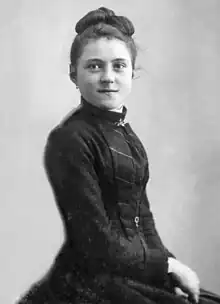
Thérèse of Lisieux OCD (French: Thérèse de Lisieux [teʁɛz də lizjø]; born Marie Françoise-Thérèse Martin; 2 January 1873 – 30 September 1897), also known as Saint Thérèse of the Child Jesus and the Holy Face (Thérèse de l'Enfant Jésus et de la Sainte Face), was a French Catholic Discalced Carmelite nun who is widely venerated in modern times. She is popularly known in English as the Little Flower of Jesus, or simply the Little Flower, and in French as la petite Thérèse ("little Thérèse").
Thérèse has been a highly influential model of sanctity for Catholics and for others because of the simplicity and practicality of her approach to the spiritual life. She is one of the most popular saints in the history of the church, although she was obscure during her lifetime. Pope Pius X called her "the greatest saint of modern times". (Full article...)
Prayer: "For me, prayer is a surge of the heart; it is a simple look turned toward heaven, it is a cry of recognition and of love, embracing both trial and joy"
Attributes: Discalced Carmelite habit, crucifix, roses
Patronage: Gardens of Vatican City; Missionaries; France; Russia; HIV/AIDS sufferers; radio care-a-thons; florists and gardeners; loss of parents; tuberculosis; aviators; bodily ills; the Russicum; Alaska; Pasay City, Antipolo City, Philippines; Australia; Cheyenne, Wyoming; Fresno, California; Pueblo, Colorado; Kisumu, Kenya; Witbank, South Africa
See also: Nicola da Forca Palena
October 2

Leodegar of Poitiers (Latin: Leodegarius; French: Léger; c. 615 – October 2, 679 AD) was a martyred Burgundian Bishop of Autun. He was the son of Saint Sigrada and the brother of Saint Warinus.
Leodegar was an opponent of Ebroin, the Frankish Mayor of the Palace of Neustria, and the leader of the faction of Burgundian nobles. His torture and death made him a martyr and saint. (Full article...)
Attributes: man having his eyes bored out with a gimlet; bishop holding a gimlet; bishop holding a hook with two prongs
Patronage: millers; invoked against blindness; eye disease; eye problems; sore eyes
See also: Memorial of the Holy Guardian Angels
October 3

The Two Ewalds (or Two Hewalds) were Saint Ewald the Black and Saint Ewald the White, martyrs in Old Saxony about 692. Both bore the same name, but were distinguished by the difference in the colour of their hair and complexions. They began their mission labours about 690 at the ancient Saxons country, now part of Westphalia, and covered by the dioceses of Münster, Osnabrück, and Paderborn. They are honored as saints in Westphalia. (Full article...)
Attributes: -
Patronage: Westphalia
See also: Adalgott; Émilie de Villeneuve; Martyrs of Natal
October 4
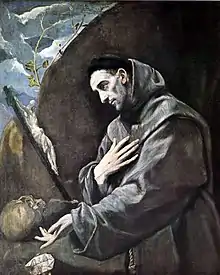
Giovanni di Pietro di Bernardone (c. 1181 – 3 October 1226), known as Francis of Assisi OFM, was an Italian mystic, poet and Catholic friar who founded the religious order of the Franciscans. He was inspired to lead a Christian life of poverty as a beggar and itinerant preacher. One of the most venerated figures in Christianity, Francis was canonized by Pope Gregory IX on 16 July 1228. He is commonly portrayed wearing a brown habit with a rope tied around his waist, featuring three knots that symbolize the three Franciscan vows of poverty, chastity, and obedience.
In 1219, he went to Egypt in an attempt to convert the sultan al-Kamil and put an end to the conflict of the Fifth Crusade. In 1223, he arranged for the first live nativity scene as part of the annual Christmas celebration in Greccio. According to Christian tradition, in 1224 Francis received the stigmata during the apparition of a Seraphic angel in a religious ecstasy. (Full article...)
Prayer: Prayer for Animals: "God Our Heavenly Father, You created the world to serve humanity's needs and to lead them to You. By our own fault we have lost the beautiful relationship which we once had with all your creation. Help us to see that by restoring our relationship with You we will also restore it with all Your creation. Give us the grace to see all animals as gifts from You and to treat them with respect for they are Your creation. We pray for all animals who are suffering as a result of our neglect. May the order You originally established be once again restored to the whole world through the intercession of the Glorious Virgin Mary, the prayers of Saint Francis and the merits of Your Son, Our Lord Jesus Christ Who lives and reigns with You now and forever. Amen."
Attributes: Dove, Stigmata, poor Franciscan habit, cross, Pax et Bonum
Patronage: animals, merchants, Italy, Meycauayan, Philippines, Catholic Action, the environment
October 5

Maria Faustyna Kowalska, OLM (born Helena Kowalska; 25 August 1905 – 5 October 1938), also known as Maria Faustyna Kowalska of the Blessed Sacrament, was a Polish Catholic religious sister and mystic. Faustyna, popularly spelled "Faustina", had apparitions of Jesus Christ which inspired the Catholic devotion to the Divine Mercy and earned her the title of "Secretary of Divine Mercy".
Throughout her life, Kowalska reported having visions of Jesus and conversations with him, which she noted in her diary, later published as The Diary of Saint Maria Faustina Kowalska: Divine Mercy in My Soul. Her biography, submitted to the Congregation for the Causes of Saints, quoted some of the conversations with Jesus regarding the Divine Mercy devotion. (Full article...)
Attributes: -
Patronage: -
See also: Anna Schäffer, Germany
October 6
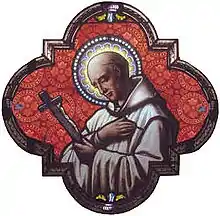
Bruno the Great (German: Brun(o) von Sachsen, "Bruno of Saxony"; Latin: Bruno Magnus; May 925 – 11 October 965 AD) was Archbishop of Cologne from 953 until his death and Duke of Lotharingia after 954. He was the brother of Otto I, Holy Roman Emperor. (Full article...)
Attributes: skull that he holds and contemplates, with a book and a cross
Patronage: Calabria
See also: Mary Frances of the Five Wounds
October 7

Justina of Padua (Italian: Santa Giustina di Padova) is a Christian saint and a patroness of Padua. Her feast day is October 7. She is often confused with Justina of Antioch. She was devoted to religion from her earliest years and took the vow of perpetual virginity. When she was brought before Maximian the prefect, she remained firm against all attacks. The prefect caused her to be slain with the sword. (Full article...)
Attributes: young woman setting a cross on the head of the devil while holding a lily in her hand; young woman with a crown, palm, and sword; young woman with a palm, book, and a sword in her breast; young woman with a unicorn, symbolizing virginity, and palm; young woman with both breasts pierced by one sword; young woman with Saint Prosdocimus; depicted as nun; young woman with Saint Scholastica
Patronage: Padua; Palmanova
October 8

Pelagia (Greek: Πελαγία), distinguished as Pelagia of Antioch, Pelagia the Penitent, and Pelagia the Harlot, was a Christian saint and hermit in the 4th or 5th century. Her feast day was celebrated on 8 October, originally in common with Saints Pelagia the Virgin and Pelagia of Tarsus. Pelagia died as a result of extreme asceticism, which had emaciated her to the point she could no longer be recognized. According to Orthodox tradition, she was buried in her cell. Upon the discovery that the renowned monk had been a woman, the holy fathers tried to keep it a secret, but the gossip spread and her relics drew pilgrims from as far off as Jericho and the Jordan valley. (Full article...)
Attributes: -
Patronage: -
October 9

John Henry Newman CO (21 February 1801 – 11 August 1890) was an English theologian, academic, philosopher, historian, writer, and poet, first as an Anglican priest and later as a Catholic priest and cardinal, who was an important and controversial figure in the religious history of England in the 19th century. He was known nationally by the mid-1830s, and was canonised as a saint in the Catholic Church in 2019.
Originally an evangelical academic at the University of Oxford and priest in the Church of England, Newman became drawn to the high-church tradition of Anglicanism. He became one of the more notable leaders of the Oxford Movement, an influential and controversial grouping of Anglicans who wished to restore to the Church of England many Catholic beliefs and liturgical rituals from before the English Reformation. In this, the movement had some success. After publishing his controversial Tract 90 in 1841, Newman later wrote: "I was on my death-bed, as regards my membership with the Anglican Church." In 1845 Newman, joined by some but not all of his followers, officially left the Church of England and his teaching post at Oxford University and was received into the Catholic Church. He was quickly ordained as a priest and continued as an influential religious leader, based in Birmingham. In 1879, he was created a cardinal by Pope Leo XIII in recognition of his services to the cause of the Catholic Church in England. He was instrumental in the founding of the Catholic University of Ireland in 1854, although he had left Dublin by 1859. (The university in time evolved into University College Dublin.) (Full article...)
Attributes: Cardinal's attire
Patronage: Personal Ordinariate of Our Lady of Walsingham
See also: Denis; Martyrs of Turon; Inocencio of Mary Immaculate; John Leonardi
October 10
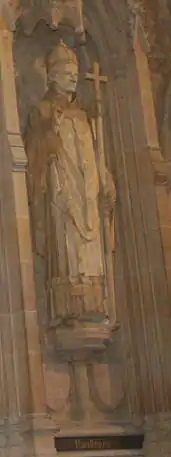
Paulinus (died 10 October 644) was a Roman missionary and the first Bishop of York. A member of the Gregorian mission sent in 601 by Pope Gregory I to Christianize the Anglo-Saxons from their native Anglo-Saxon paganism, Paulinus arrived in England by 604 with the second missionary group. Little is known of Paulinus's activities in the following two decades.
After some years spent in Kent, perhaps in 625, Paulinus was consecrated a bishop. He accompanied Æthelburg of Kent, sister of King Eadbald of Kent, on her journey to Northumbria to marry King Edwin of Northumbria, and eventually succeeded in converting Edwin to Christianity. Paulinus also converted many of Edwin's subjects and built some churches. One of the women Paulinus baptised was a future saint, Hilda of Whitby. (Full article...)
Attributes: An archbishop holding a model of a small wooden church; baptizing Edwin of Northumbria
Patronage: York; Rochester; those displaced from office
See also: Eulampius and Eulampia; Daniele Comboni
October 11

Pope John XXIII (Latin: Ioannes XXIII; Italian: Giovanni XXIII; born Angelo Giuseppe Roncalli, Italian: [ˈandʒelo dʒuˈzɛppe roŋˈkalli]; 25 November 1881 – 3 June 1963) was head of the Catholic Church and sovereign of the Vatican City State from 28 October 1958 until his death in June 1963. He was among 13 children born to Marianna Mazzola and Giovanni Battista Roncalli in a family of sharecroppers who lived in Sotto il Monte, a village in the province of Bergamo, Lombardy. He was ordained to the priesthood on 10 August 1904 and served in a number of posts, as nuncio in France and a delegate to Bulgaria, Greece and Turkey. In a consistory on 12 January 1953 Pope Pius XII made Roncalli a cardinal as the Cardinal-Priest of Santa Prisca in addition to naming him as the Patriarch of Venice. Roncalli was unexpectedly elected pope on 28 October 1958 at age 76 after eleven ballots. Pope John XXIII surprised those who expected him to be a caretaker pope by calling the historic Second Vatican Council (1962–1965), the first session opening on 11 October 1962, which is now his feast. (Full article...)
Attributes: Papal vestments, Papal tiara, Camauro
Patronage: Papal delegates, Patriarchy of Venice, Second Vatican Council, Christian unity, Diocese of Bergamo, Sotto il Monte, Valsamoggia, Italian Army
See also: Andronicus, Probus, and Tarachus; Alexander Sauli; Maria Soledad Torres y Acosta, Spain
October 12

Wilfrid (c. 633 – 709 or 710) was an English bishop and saint. Born a Northumbrian noble, he entered religious life as a teenager and studied at Lindisfarne, at Canterbury, in Francia, and at Rome; he returned to Northumbria in about 660, and became the abbot of a newly founded monastery at Ripon. In 664 Wilfrid acted as spokesman for the Roman position at the Synod of Whitby, and became famous for his speech advocating that the Roman method for calculating the date of Easter should be adopted. His success prompted the king's son, Alhfrith, to appoint him Bishop of Northumbria. Wilfrid chose to be consecrated in Gaul because of the lack of what he considered to be validly consecrated bishops in England at that time. During Wilfrid's absence Alhfrith seems to have led an unsuccessful revolt against his father, Oswiu, leaving a question mark over Wilfrid's appointment as bishop. Before Wilfrid's return Oswiu had appointed Ceadda in his place, resulting in Wilfrid's retirement to Ripon for a few years following his arrival back in Northumbria. (Full article...)
Attributes: (1) baptizing; (2) preaching; (3) landing from a ship and received by the king; or (4) engaged in theological disputation with his crozier near him and a lectern before him
Patronage: Diocese of Middlesbrough; Ripon
October 13

Edward the Confessor (c. 1003 – 5 January 1066) was an Anglo-Saxon English king and saint. Usually considered the last king of the House of Wessex, he ruled from 1042 until his death in 1066.
Edward was the son of Æthelred the Unready and Emma of Normandy. He succeeded Cnut the Great's son – and his own half-brother – Harthacnut. He restored the rule of the House of Wessex after the period of Danish rule since Cnut conquered England in 1016. When Edward died in 1066, he was succeeded by his wife's brother Harold Godwinson, who was defeated and killed in the same year at the Battle of Hastings by the Normans under William the Conqueror. Edward's young great-nephew Edgar the Ætheling of the House of Wessex was proclaimed king after the Battle of Hastings, but was never crowned and was peacefully deposed after about eight weeks. (Full article...)
Attributes: King crowned with nimbus, sceptre, martlet
Patronage: Difficult marriages; separated spouses; England (before 1347); English Royal Family; Kings
See also: Theophilus of Antioch; Gerald of Aurillac
October 14
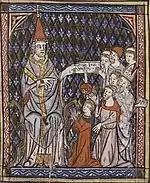
Pope Callixtus I (Greek: Κάλλιστος), also called Callistus I, was the bishop of Rome (according to Sextus Julius Africanus) from c. 218 to his death c. 222 or 223. He lived during the reigns of the Roman emperors Elagabalus and Alexander Severus. Eusebius and the Liberian catalogue list his episcopate as having lasted five years (217–222). In 217, when Callixtus followed Zephyrinus as Bishop of Rome, he started to admit into the Church converts from sects or schisms. He was martyred for his Christian faith and is venerated as a saint by the Catholic Church (the patron saint of cemetery workers). (Full article...)
Attributes: -
Patronage: Cemetery workers
October 15
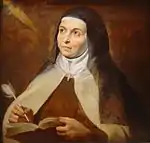
Teresa of Ávila, OCD (Teresa Sánchez de Cepeda Dávila y Ahumada; 28 March 1515 – 4 or 15 October 1582), also called Saint Teresa of Jesus, was a Carmelite nun and prominent Spanish mystic and religious reformer. (Full article...)
Attributes: habit of the Discalced Carmelites, book and quill, arrow-pierced heart
Patronage: bodily ills; headaches; lacemakers; laceworkers; loss of parents; people in need of grace; people in religious orders; people ridiculed for their piety; Požega, Croatia; sick people; sickness; Spain
October 16
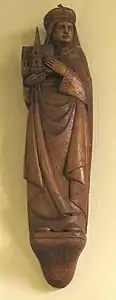
Hedwig of Silesia (Polish: Święta Jadwiga Śląska), also Hedwig of Andechs (German: Heilige Hedwig von Andechs, Latin: Hedvigis; 1174 – 15 October 1243), a member of the Bavarian comital House of Andechs, was Duchess of Silesia from 1201 and of Greater Poland from 1231 as well as High Duchess consort of Poland from 1232 until 1238. She was canonized by the Catholic Church in 1267 by Pope Clement IV. (Full article...)
Attributes: -
Patronage: Brandenburg, Berlin, Silesian expellees, Silesia and its capital Wrocław, Trzebnica, the Diocese of Görlitz, Andechs Abbey, Cracow
See also: Margaret Mary Alacoque, France; Gerard Majella; Marie-Marguerite d'Youville, Canada
October 17
_-_Ignatios.jpg.webp)
Ignatius of Antioch (/ɪɡˈneɪʃəs/; Greek: Ἰγνάτιος Ἀντιοχείας, translit. Ignátios Antiokheías; died c. 108/140 AD), also known as Ignatius Theophorus (Ἰγνάτιος ὁ Θεοφόρος, Ignátios ho Theophóros, 'the God-bearing'), was an early Christian writer and Patriarch of Antioch. While en route to Rome, where he met his martyrdom, Ignatius wrote a series of letters. This correspondence forms a central part of a later collection of works by the Apostolic Fathers. He is considered one of the three most important of these, together with Clement of Rome and Polycarp. His letters also serve as an example of early Christian theology, and address important topics including ecclesiology, the sacraments, and the role of bishops. (Full article...)
Attributes: a bishop surrounded by lions or in chains
Patronage: Church in eastern Mediterranean; Church in North Africa
See also: Richard Gwyn, England
October 18
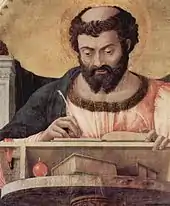
Luke the Evangelist is one of the Four Evangelists—the four traditionally ascribed authors of the canonical gospels. The Early Church Fathers ascribed to him authorship of both the Gospel of Luke and the Acts of the Apostles. Prominent figures in early Christianity such as Jerome and Eusebius later reaffirmed his authorship, although a lack of conclusive evidence as to the identity of the author of the works has led to discussion in scholarly circles, both secular and religious. (Full article...)
Prayer: "Most charming and saintly Physician, you were animated by the heavenly Spirit of love. In faithfully detailing the humanity of Jesus, you also showed his divinity and his genuine compassion for all human beings. Inspire our physicians with your professionalism and with the divine compassion for their patients. Enable them to cure the ills of both body and spirit that afflict so many in our day. Amen"
Attributes: Apostle of Jesus, Evangelist, Physician, Bishop book, man accompanied by a winged ox, ox, painting an icon of Blessed Virgin Mary, brush or palette (referring to the tradition that he was a painter), winged calf, or a winged ox.
Patronage: artists, bachelors, bookbinders, brewers, butchers, Capena Italy, doctors, glass makers, glassworkers, gold workers, goldsmiths, Hermersdorf Germany, lacemakers, lace workers, notaries, painters, physicians, sculptors, stained glass workers, surgeons, unmarried men
October 19

Jean de Brébeuf (French: [ʒɑ̃ də bʁe.bœf]) (25 March 1593 – 16 March 1649) was a French Jesuit missionary who travelled to New France (Canada) in 1625. There he worked primarily with the Huron for the rest of his life, except for a few years in France from 1629 to 1633. He learned their language and culture, writing extensively about each to aid other missionaries.
In 1649, Brébeuf and another missionary were captured when an Iroquois raid took over a Huron village (referred to in French as St. Louis). Together with Huron captives, the missionaries were ritually tortured and killed on 16 March 1649. Brébeuf was beatified in 1925 and among eight Jesuit missionaries canonized as saints in the Catholic Church in 1930. (Full article...)
Attributes: Pyx
Patronage: Canada
See also: Canadian Martyrs; Isaac Jogues, Canada; Philip Howard, England; Paul of the Cross
October 20

Saint Irene of Tomar (Portuguese: Santa Iria) (c.635 – c.653) was a Christian who was martyred for her faith in Visigothic Portugal. Her parents, wishing to protect her, sent her to a convent school and a private tutor. The only times she left her house was to attend Mass or pray at the sanctuary of Saint Peter. The legend of her life is possibly little more than that. (Full article...)
Attributes: as a nun, with the palm of martyrdom
Patronage: Tomar, Portugal
See also: Acca of Hexham, England; Maria Bertilla Boscardin
October 21

John Twenge (Saint John of Bridlington, John Thwing, John of Thwing, John Thwing of Bridlington) (1320–1379) is an English saint of the 14th century. In his lifetime he enjoyed a reputation for great holiness and for miraculous powers. St John of Bridlington was commended for the integrity of his life, his scholarship, and his quiet generosity. He was the last English saint to be canonised before the English Reformation. (Full article...)
Attributes: fish, book, crozier, fur almice; muzzled animal at his feet
Patronage: women in difficult labour; fishermen
See also: Laura Montoya
October 22
.jpg.webp)
Pope John Paul II (Latin: Ioannes Paulus II; Italian: Giovanni Paolo II; Polish: Jan Paweł II; born Karol Józef Wojtyła [ˈkarɔl ˈjuzɛv vɔjˈtɨwa]; 18 May 1920 – 2 April 2005) was head of the Catholic Church and sovereign of the Vatican City State from 1978 until his death in 2005. (Full article...)
Attributes: Papal ferula, Papal vestments
Patronage: Poland; Archdiocese of Kraków; World Youth Day (co-Patron); World Meeting of Families 2015 (co-patron); Young Catholics; Families; Świdnica; Trecastelli; Borgo Mantovano; Rivignano Teor; Paradahan, Tanza, Cavite (in Philippines)
See also: Donatus of Fiesole
October 23

John of Capistrano, OFM (Italian: San Giovanni da Capestrano, Hungarian: Kapisztrán János, Polish: Jan Kapistran, Croatian: Ivan Kapistran; 24 June 1386 – 23 October 1456) was a Franciscan friar and Catholic priest from the Italian town of Capestrano, Abruzzo. Famous as a preacher, theologian, and inquisitor, he earned himself the nickname "the Soldier Saint" when in 1456 at age 70 he led a Crusade against the invading Ottoman Empire at the siege of Belgrade with the Hungarian military commander John Hunyadi.
Elevated to sainthood, he is the patron saint of jurists and military chaplains, as well as the namesake of two Franciscan missions, one in Southern California and the other in San Antonio, Texas. (Full article...)
Attributes: habit of a Franciscan, with cross, cross flag and star, on the battlefield
Patronage: Jurists, Belgrade and Hungary
October 24
.jpg.webp)
Anthony Mary Claret, CMF (Catalan: Antoni Maria Claret i Clarà; Spanish: Antonio María Claret y Clarà; December 23, 1807 – October 24, 1870) was a Spanish Catholic prelate and missionary who served as Archbishop of Santiago de Cuba and was the confessor of Isabella II of Spain. He founded the congregation of Missionary Sons of the Immaculate Heart of Mary, commonly called the Claretians.
In addition to the Claretians, which in the early 21st century had over 450 houses and 3100 members, with missions in five continents, Claret founded or drew up the rules of several communities of religious sisters. His zealous life and the wonders he wrought, both before and after his death, testified to his sanctity. Claret is the patron saint of weavers. (Full article...)
Attributes: Bishop's robe, crozier, an open book, catechism, 2 students beside him at his side and having his bent arm pointing to the sky
Patronage: Textile merchants, weavers, savings (taught the poor the importance of savings), Catholic press, Claretians, Dioceses of the Canary Islands, Claretian students, Claretian educators and Claretian educational institutions, Foundations
See also: Luigi Guanella; Rafael Guízar y Valencia, Mexico
October 25
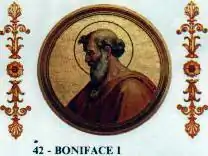
Pope Boniface I (Latin: Bonifatius I) was the bishop of Rome from 28 December 418 to his death on 4 September 422. His election was disputed by the supporters of Eulalius until the dispute was settled by Emperor Honorius. Boniface was active in maintaining church discipline, and he restored certain privileges to the metropolitical sees of Narbonne and Vienne, exempting them from any subjection to the primacy of Arles. He was a contemporary of Augustine of Hippo, who dedicated to him some of his works. (Full article...)
Attributes: -
Patronage: -
See also: Eustace White; John Houghton, England; John Roberts, England; Cuthbert Mayne, England; Eustace White, England
October 26
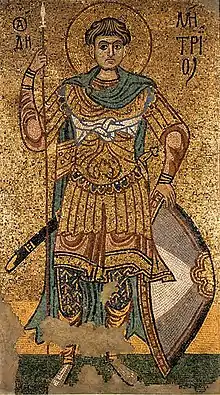
Saint Demetrius (or Demetrios) of Thessalonica (Greek: Ἅγιος Δημήτριος τῆς Θεσσαλονίκης, Hágios Dēmḗtrios tēs Thessaloníkēs), also known as the Holy Great-Martyr Demetrius the Myroblyte (meaning 'the Myrrh-Gusher' or 'Myrrh-Streamer'; 3rd century – 306), was a Greek Christian martyr of the early 4th century AD.
During the Middle Ages, he came to be revered as one of the most important Orthodox military saints, often paired with Saint George of Lydda. His feast day is 26 October for Eastern Orthodox Christians, which falls on 8 November [NS, "new style"] for those following the old calendar. In the Roman Catholic Church he is most commonly called "Demetrius of Sermium" and his memorial is 9 April in the 2004 Roman Martyrology and 8 October in the martryology of the Extraordinary Form. (Full article...)
Attributes: depicted wearing the armour of a Roman soldier, usually carrying a spear, often seated on a red horse
Patronage: Thessaloniki, Siberia, Sremska Mitrovica, Kosovska Mitrovica; soldiers; Crusades (in Roman Catholic tradition); agriculture, peasants and shepherds (in the Greek countryside during Middle Ages)
October 27

Frumentius (Ge'ez: ፍሬምናጦስ; died c. 383) was a Phoenician Christian missionary and the first bishop of Axum who brought Christianity to the Kingdom of Aksum. He is sometimes known by other names, such as Abuna ("Our Father") and Aba Salama ("Father of Peace").
He was ethnically a Phoenician, according to Rufinus, born in Tyre, modern day Lebanon. As a boy, he was captured with his brother on a voyage, and they became slaves to the King of Axum. He freed them shortly before his death, and they were invited to educate his young heir. They also began to teach Christianity in the region. Later, Frumentius traveled to Alexandria, Egypt, where he appealed to have a bishop appointed and missionary priests sent south to Axum. Thereafter, he was appointed bishop and established the Church in Ethiopia, converting many local people, as well as the king. His appointment began a tradition that the Patriarch of Alexandria appoint the bishops of Ethiopia. (Full article...)
Attributes: -
Patronage: Kingdom of Aksum
October 28
_Saint_Jude_Thadd%C3%A9e_1620_-_Georges_de_La_Tour_Inv.166.jpg.webp)
Jude (Greek: Ἰούδας Ἰακώβου translit. Ioúdas Iakóbou; Syriac/Aramaic: ܝܗܘܕܐ translit. Yahwada) was one of the Twelve Apostles of Jesus according to the New Testament. He is generally identified as Thaddeus (Greek: Θαδδαῖος; Armenian: Թադեոս; Coptic: ⲑⲁⲇⲇⲉⲟⲥ) and is also variously called Judas Thaddaeus, Jude Thaddaeus, Jude of James, or Lebbaeus. He is sometimes identified with Jude, the brother of Jesus, but is clearly distinguished from Judas Iscariot, the disciple who betrayed Jesus prior to his crucifixion. Catholic writer Michal Hunt suggests that Judas Thaddaeus became known as Jude after early translators of the New Testament from Greek into English sought to distinguish him from Judas Iscariot and subsequently abbreviated his forename. Most versions of the New Testament in languages other than English and French refer to Judas and Jude by the same name. (Full article...)
Attributes: axe, club, boat, oar, medallion
Patronage: Armenia, lost causes, desperate situations, hospitals, St. Petersburg, Florida, the Chicago Police Department, Clube de Regatas do Flamengo from Rio de Janeiro, Brazil.
See also: Simon the Zealot
October 29
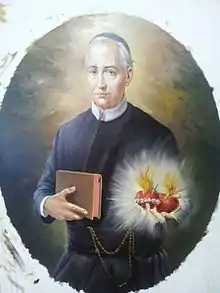
Gaetano Errico (19 October 1791 – 29 October 1860) was an Italian Roman Catholic priest from Naples and the founder of the Missionari dei Sacri Cuori di Gesù e Maria. Errico was born to devout and hardworking parents whose income was modest but sufficient for him to do his ecclesial studies in Naples. It was common for him to be seen twice a week tending to the ill despite his studies and he also helped his father on occasion at his warehouse. He became a teacher after his ordination and later a parish priest. (Full article...)
Attributes: Crucifix, Sacred Heart, Priest's cassock
Patronage: Missionari dei Sacri Cuori di Gesù e Maria
See also: Colman mac Duagh, Douai Martyrs
October 30

Alphonsus Rodríguez, SJ (Spanish: Alfonso) (25 July 1532 – 31 October 1617) was a Spanish Jesuit religious brother who is venerated as a saint in the Catholic Church. (Full article...)
Attributes: -
Patronage: -
See also: Gerard of Potenza, Luca Antonio Falcone
October 31

Wolfgang of Regensburg (Latin: Wolfgangus; c. 934 – 31 October 994 AD) was bishop of Regensburg in Bavaria from Christmas 972 until his death. He is a saint in the Catholic and Eastern Orthodox churches. He is regarded as one of the three great German saints of the 10th century, the other two being Ulrich of Augsburg and Conrad of Constance. Towards the end of his life Wolfgang withdrew as a hermit to a solitary spot, in the Salzkammergut region of Upper Austria. Soon after Wolfgang's death many churches chose him as their patron saint, and various towns were named after him. (Full article...)
Attributes: forcing the devil to help him to build a church; episcopal dress; depicted with an axe in the right hand and the crozier in the left; or as a hermit in the wilderness being discovered by a hunter.
Patronage: apoplexy; carpenters and wood carvers; paralysis; Regensburg, Germany; stomach diseases; strokes
See also: Alphonsus Rodriguez, Spain